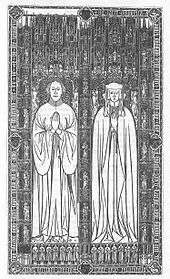Brass rubbing


Brass rubbing was originally a largely British enthusiasm for reproducing onto paper monumental brasses – commemorative brass plaques found in churches, usually originally on the floor, from between the thirteenth and sixteenth centuries. The concept of recording textures of things is more generally called making a rubbing. What distinguishes rubbings from frottage is that rubbings are meant to reproduce the form of something being transferred, whereas frottage is usually only intended to utilise a general texture.
Brass rubbings are created by laying a sheet of paper on top of a brass (actually called "latten" - an alloy of brass and nickel) and rubbing the paper with graphite, wax, or chalk, a process similar to rubbing a pencil over a piece of paper placed on top of a coin. In the "old days" rubbings were most commonly made using the equivalent of what nowadays is called "butcher's paper" [a 22–30-inch-wide (560–760 mm) roll of whitish paper] laid down over the brass and rubbed with "heelball", a waxy glob of black crayon once used to shine shoes. Now most brass rubbers purchase special paper rolls of heavy duty black velvety material, and the crayons are gold, silver or bronze (other colours are available).
Brass plaques are slowly but surely worn away by the rubbing process and in many cases creating rubbings is banned. Brass rubbing centres with replicas of original brass plaques have become a prime source for brass rubbings in the UK.[1] Replicas are often not the same scale as the original.
See also
References
- Monumental Brasses as Art and History ed. Jerome Bertram, published by Alan Sutton.